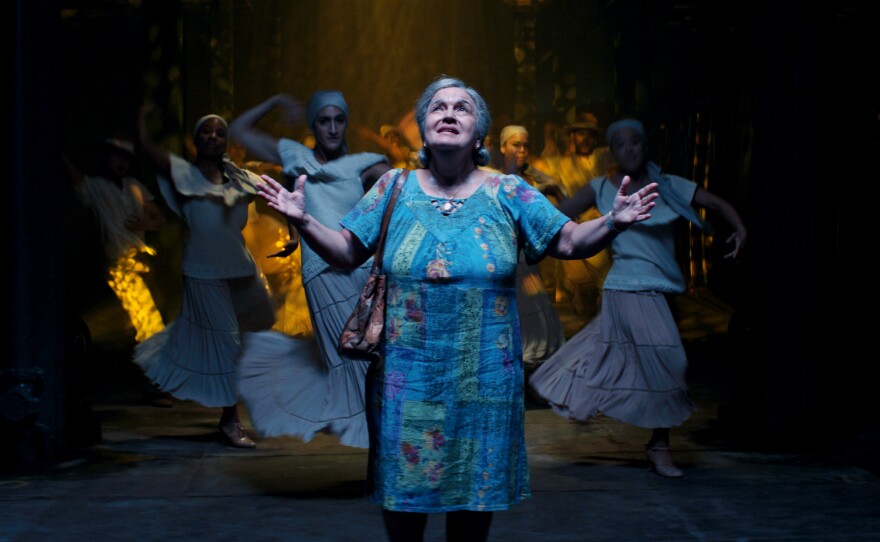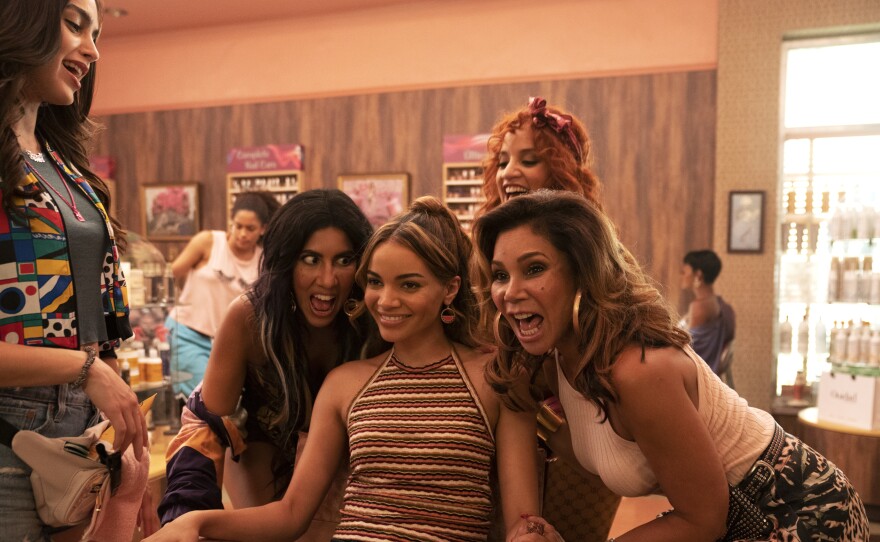“In the Heights” opened last week, it serves up a rare commodity: a big budget Hollywood musical created by a Puerto Rican American, directed by an Asian American and featuring a racially diverse cast.
Could this herald a change in Hollywood?
Carrying a heavy burden
Calixto Chinchilla runs the New York Latino Film Festival and has been following the evolution of “In the Heights” since it began percolating in the mind of Lin-Manuel Miranda more than a decade ago.
"It's truly a love letter to this neighborhood," Chinchilla said. "I was in Washington Heights, I grew up there. So all of that sentiment is real, the displacement is real because I don't live there anymore. The unfortunate thing is that the Heights is changing, the gentrification is real, a lot of us can't afford to be there anymore. It's a different neighborhood so that even that movie becomes the time capsule, if you will."
The lead character of Usnavi asks the kids to say the name of Washington Heights so it won't disappear because even when Miranda was writing the play he knew the community was changing.
“In the Heights” tells a particular story about one community, but Latino playwright Herbert Siguenza said that’s not how Hollywood sees it: "They put us all in this one homogeneous group and it is just very unfortunate."
RELATED: The Limitations Of ‘Latinidad’: How Colorism Haunts ‘In The Heights’
Unfortunate and problematic.
"We put too much pressure on these movies because it's the one film of the whole year," said Ethan van Thillo, founder of the San Diego Latino Film Festival. "I've seen this over the years. All this pressure was put on this one film. And if it's not a success, then they say, OK, well, that's why their audiences don’t want to see their movies."
That's because films about Latino and Latinx stories are just too few and far between.
"We put a lot of pressure on them because we want them to represent all of our feelings, all of our history, all of our nuances. And that's just impossible. It's just impossible," Siguenza said.

Cinematic context
Over the decades, both Siguenza and Van Thillo have grown jaded about Hollywood telling their stories.
"I heard a lot of people celebrating, 'Oh, my gosh, "in the Heights," it's going to be a big change. We're going to see more Latinos in front of the screen, behind the screen.'" Van Thillo said. "But unfortunately I've heard that before. We've seen that a few times with other films."
Films like “Zoot Suit,” which challenged stereotypes 40 years ago.
"It's always important to remember those who have come before us and films like 'Zoot Suit' paved the way for someone like Miranda to even make what he's currently made, and to Hollywood to even distribute what's being made," Van Thillo stated.
But “Zoot Suit” was politically provocative in a way that “In the Heights” is not.
"So I am really glad about films that try to push the boundaries a little bit and promote social justice issues and and promote educating the community," said Van Thillo. "I would say 'In the Heights' is more a little bit about a fantasy. It's a little more kind of like glossing over the realities of what's currently taking place."
The film even starts with Usnavi telling a story that begins with: "Once upon a time, in a faraway land known as Washington Heights …"
The Washington Heights of the film is about as realistic as the New York of “West Side Story,” which celebrates its 60th anniversary this year. Siguenza sees a similarity in the way the two films avoid politics.

"They really don't get deep. It's really about the dancing, the dancing and the love stories that really are carrying these films," he said.
For a young Latino filmmaker like Luis Martinez of 2AM Burrito Productions, the film was a mixed bag.
"I would have liked to see a Latinx director have the reigns of this even if it was Lin-Manuel," Martinez said. "But It made me feel really good to see it on the screen and made me feel really good that a studio put its money behind a project like that, but if I were to say, they got it 75% right, 75 to 80% spot on."
“In the Heights,” which opened in theaters and streaming on HBO Max, underperformed in Hollywood’s eyes. But Martinez said that’s an easy story to pitch an editor.
"'In the Heights' underperforms, what does this spell for Latin audiences moving forward? But I think the people that are going to make the next project are going to get the real streaming numbers from HBO … When you have access of dual releases online, you know every HBO Max password out there is getting used by three or four different Latino families. That's close to 80 people that could have theoretically watched the movie during the weekend," Martinez said.
No matter how the film performed, the Latino community is excited about the film.
"You can sense the excitement among the Latino film community, other film festivals across the country and then locally just seeing how families are already reacting via social media in the sense of pride and seeing oneself on the big screen," said Van Thillo.
"People are loving it, are crying," Siguenza added. "But I think people are just reacting emotionally because we just don't see ourselves. We just don't see ourselves on film. We have tons of stories but we are just not represented in Hollywood."
Being both supportive and critical of the film
Martinez suggests celebrating the film while still taking time to criticize it where necessary.
"I think that as long as we have that conversation while still supporting it, so that more artists like myself and other artists that are out there creating content and telling stories and a lot of us have the chance to make more films is what I would like to see come out of this," Martinez said.
But Siguenza felt that old cynicism creeping in because he doesn’t see “In the Heights” opening any doors.
"There's not a lot of follow up. I don't know of any big Latino projects coming out that are going to like follow it up next year. I don't hear anything following up this," Siguenza said.
When Van Thillo started the San Diego Latino Film Festival almost three decades ago, a film like "In the Heights" was just a dream. Back then he was pushing Hollywood to simply make Latin stories and not whitewash Latino characters like “West Side Story” did.
"I think we're at a point now that we need to have Latinos portraying Latinos on screen and that musical obviously didn’t. And so 'In the Heights' takes us to the next level," Van Thillo said. "However, we're still not there, right? I mean, we still don't have the Latino director directing the film."
But Chinchilla defended the choice of Jon M. Chu as director: "Being Asian is not, you know, is not a majority either. And he knows how to direct musicals having done a couple of the 'Step Up' films."

Siguenza sees it as a labor issue: "Because you're not going to get the second job if you didn't get the first job."
Martinez said that perhaps a Latinx director would have been more sensitive to the diversity within the Latino community than a California-raised Asian American.
"And I think maybe that was why there's so much of this backlash about the casting and about specifically not enough Afro Latinos displayed in the film other than dancing in the background," Martinez said. "We have to have the internal conversation about, you know, Latino and Latino racism, colorism, you know, colonialism, all these things that that that come up, that that become important."
Latinos make up a quarter of the moviegoing audience and Hollywood needs to reflect that onscreen. That’s why Martinez insists it’s important to support “In the Heights” even if it’s not perfect.
"We can be celebrating the fact that this is happening, we can also kind of center ourselves and say every movie is not going to be able to be everything for every person," he said.
"One film cannot represents the entire community," added Van Thillo. "So it's important that “In the Heights” to be the first of many new films."
Chinchilla urges people to not just support the film but to see it in a theater and not streaming on HBO Max.
"But the way he (Chu) opens it up and uses his imagination. There are big explosive numbers. It is shot in anamorphic, and to hear it in the Dolby Theater. We've come too far as a people in overcoming this pandemic so come out and go to the theater, celebrate it, celebrate the culture, celebrate life, see this film the way it ought to be. And so I urge everybody to do the same, because this doesn't happen often. It doesn't happen often at all," Chinchilla said.
There is a line in the play that states: "Little details that tell the world we are not invisible."
"I really like," Siguenza said. "That is a theme that we got to really live up to. Like we have to have more movies with specific details that really show us as human beings, as three dimensional characters and not just cartoonish dancers I want to see something more substantive."
“In the Heights” may be a long way from “West Side Story,” but Hollywood still has a long way to go to represent the diversity of the Latino and Latinx communities.







